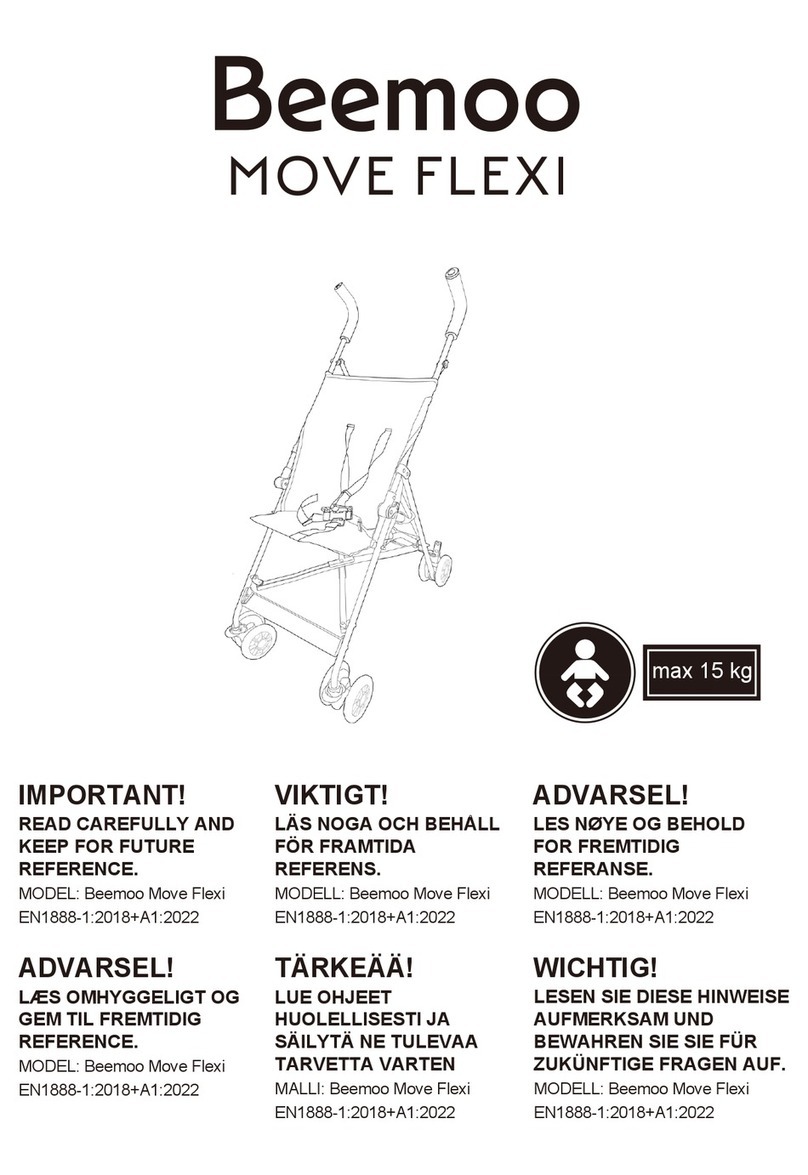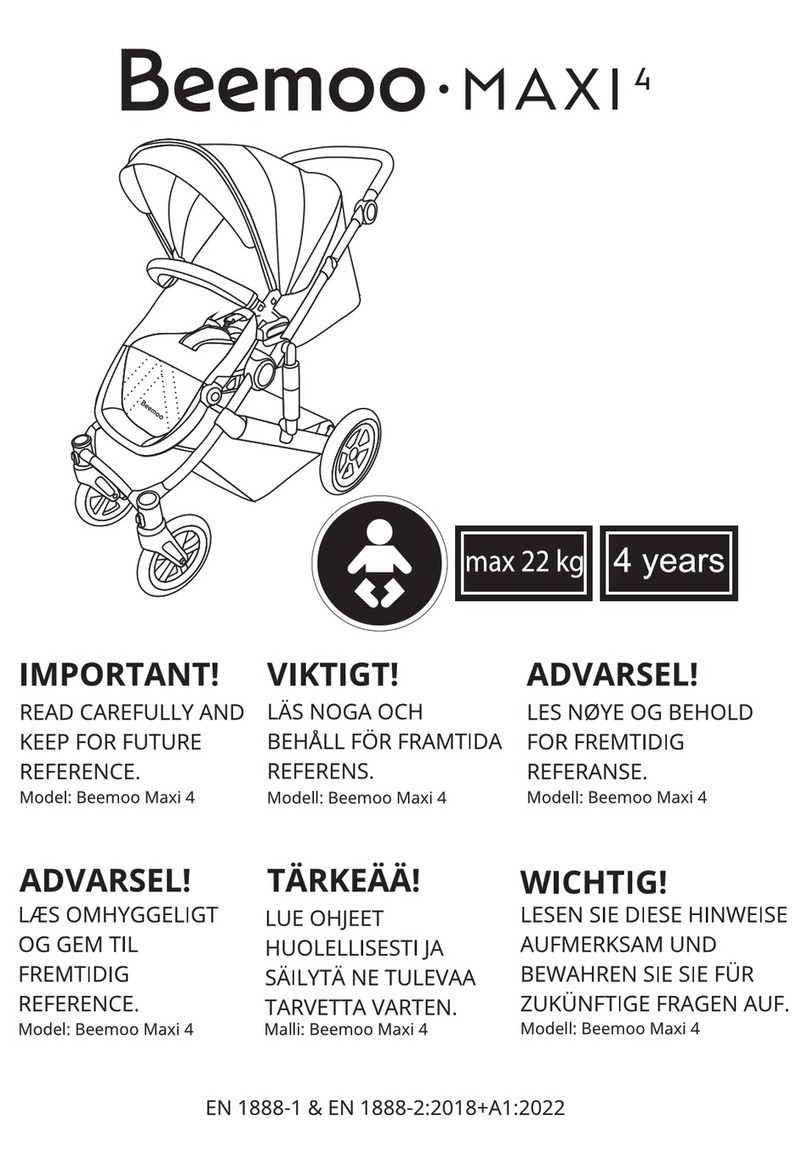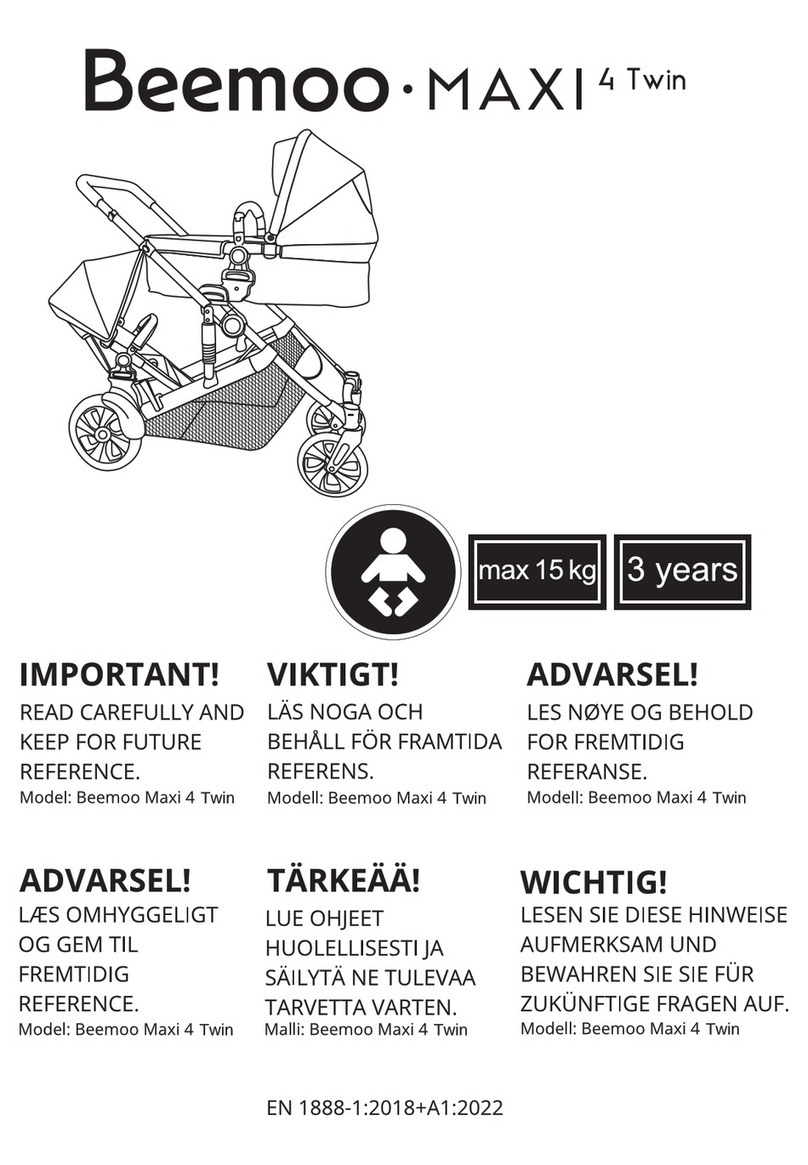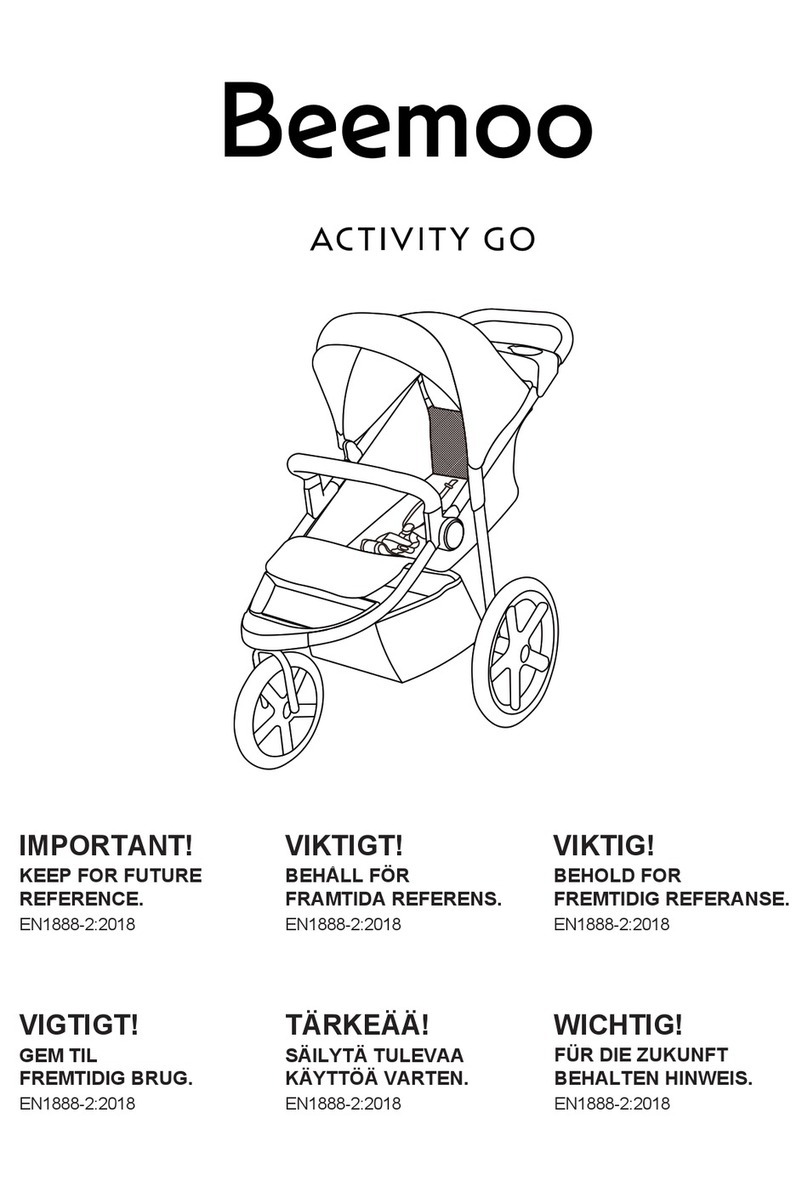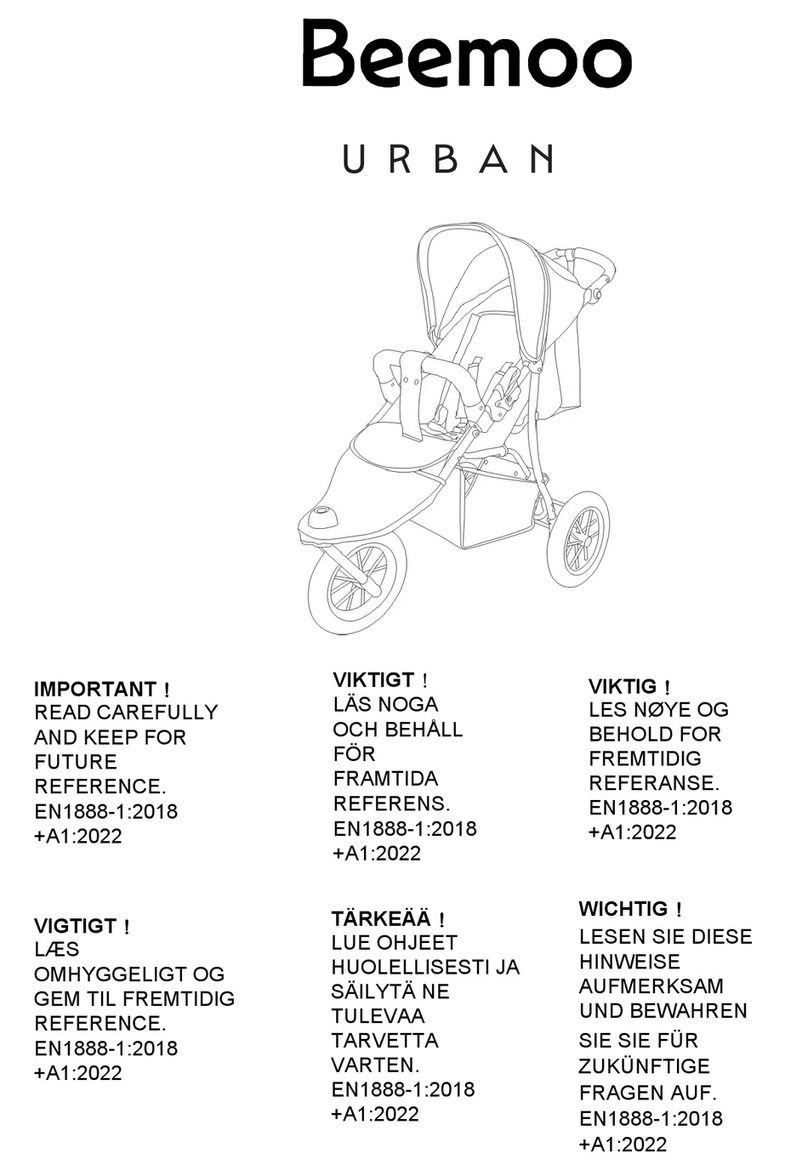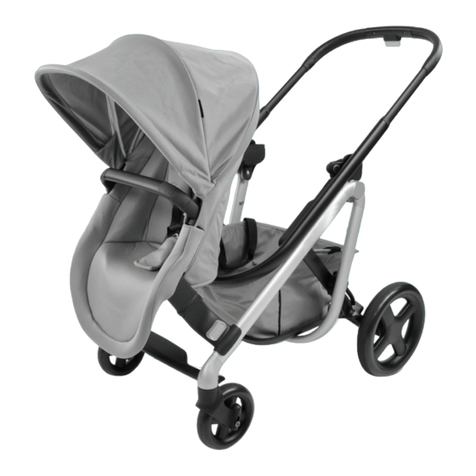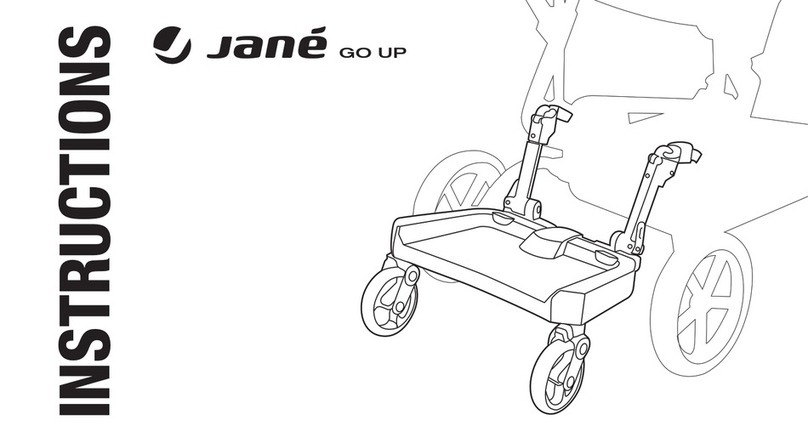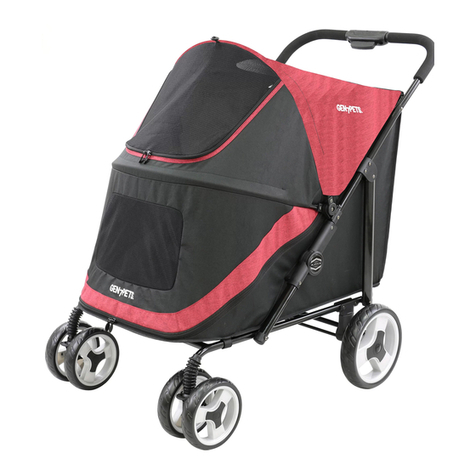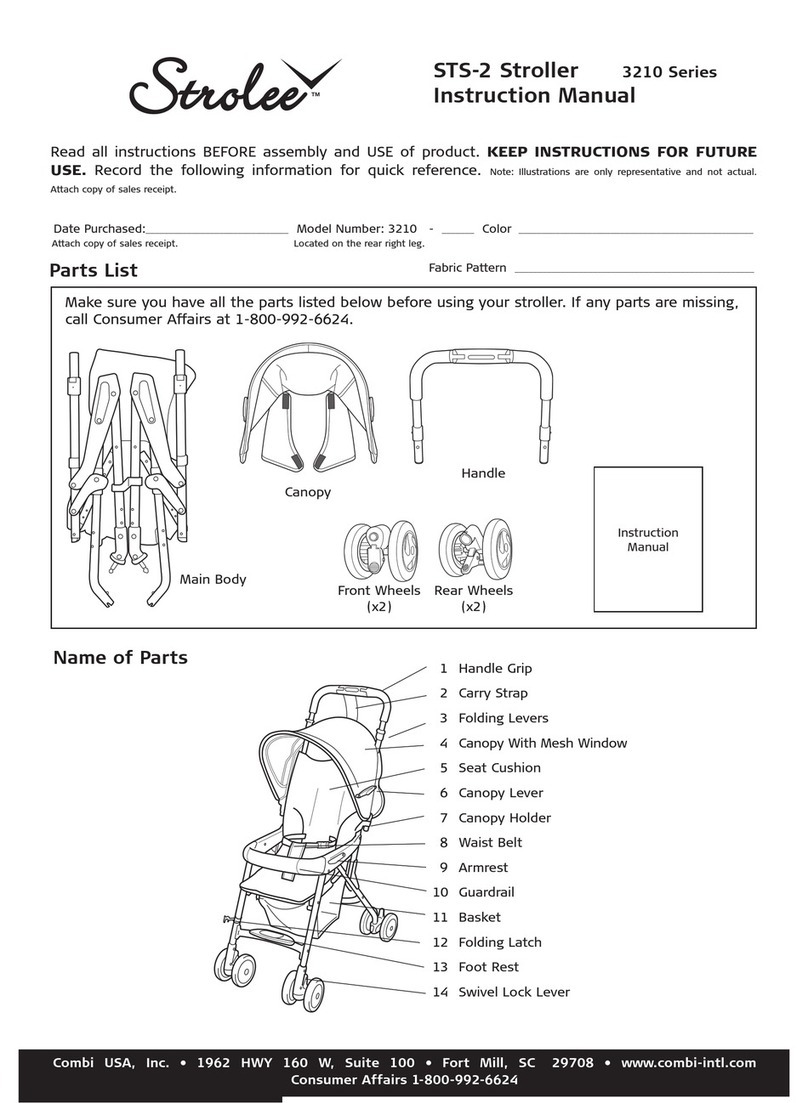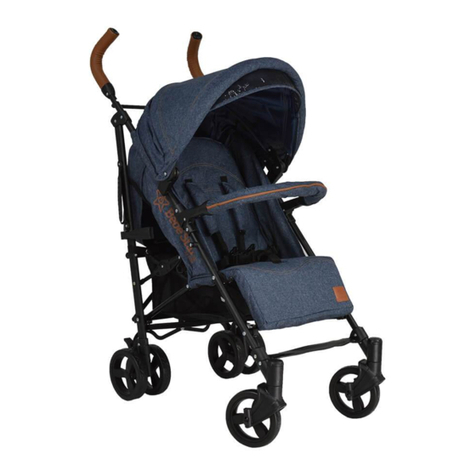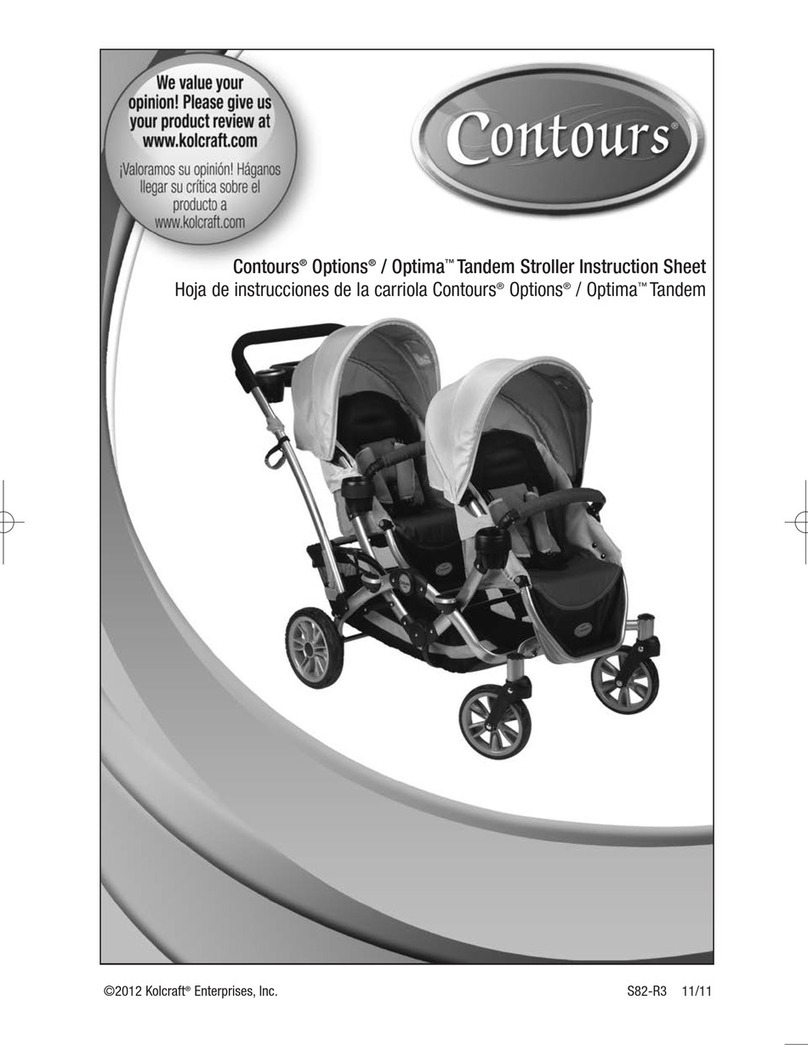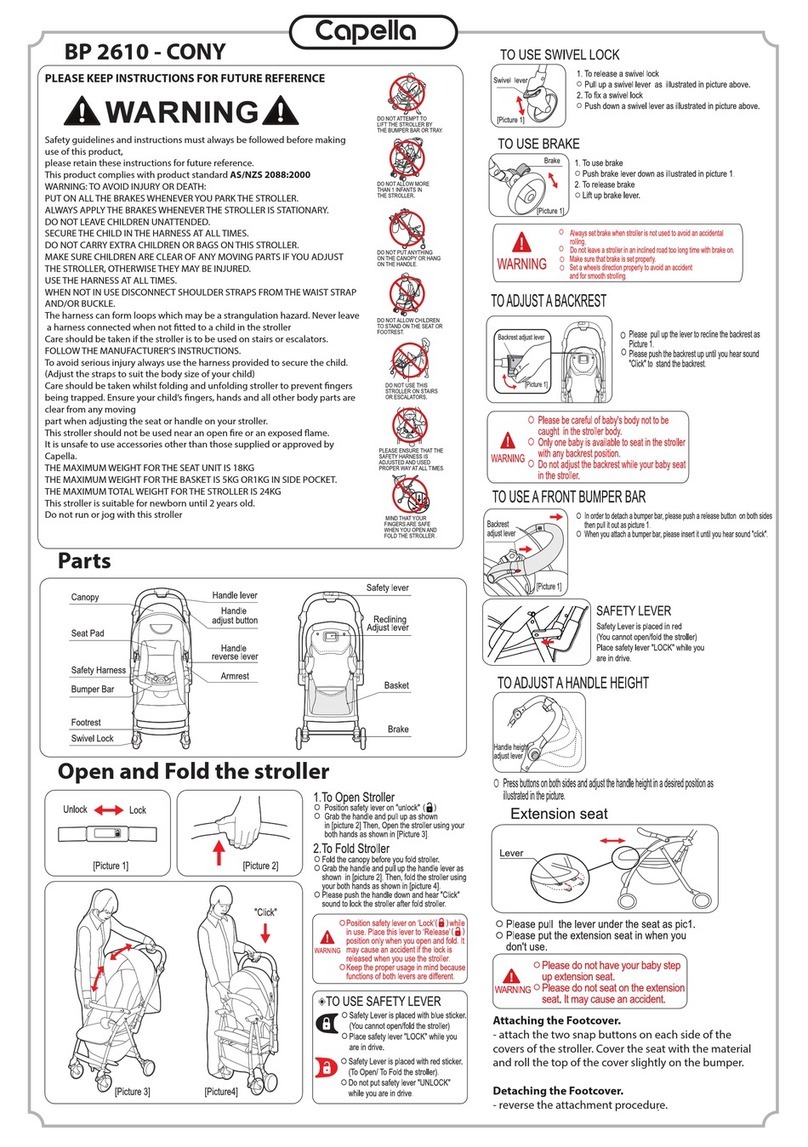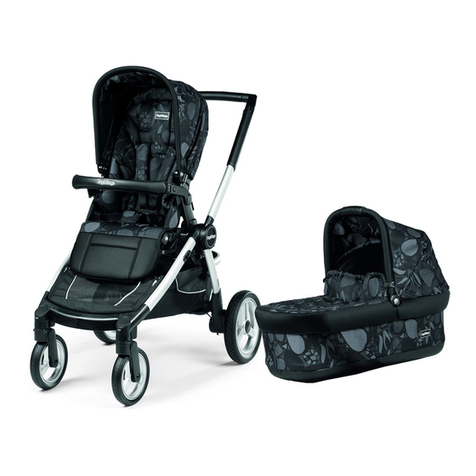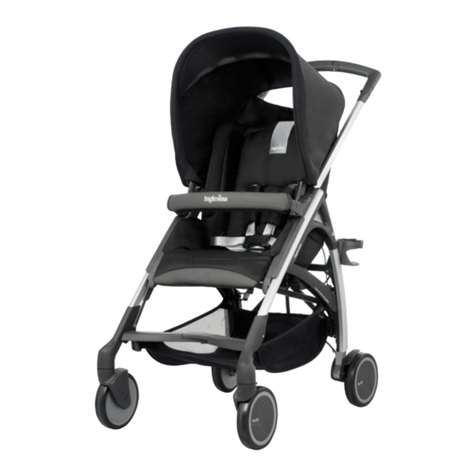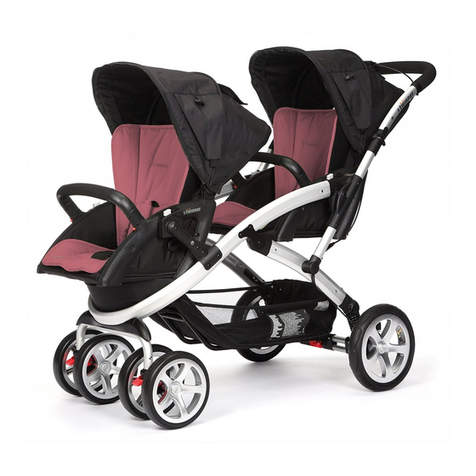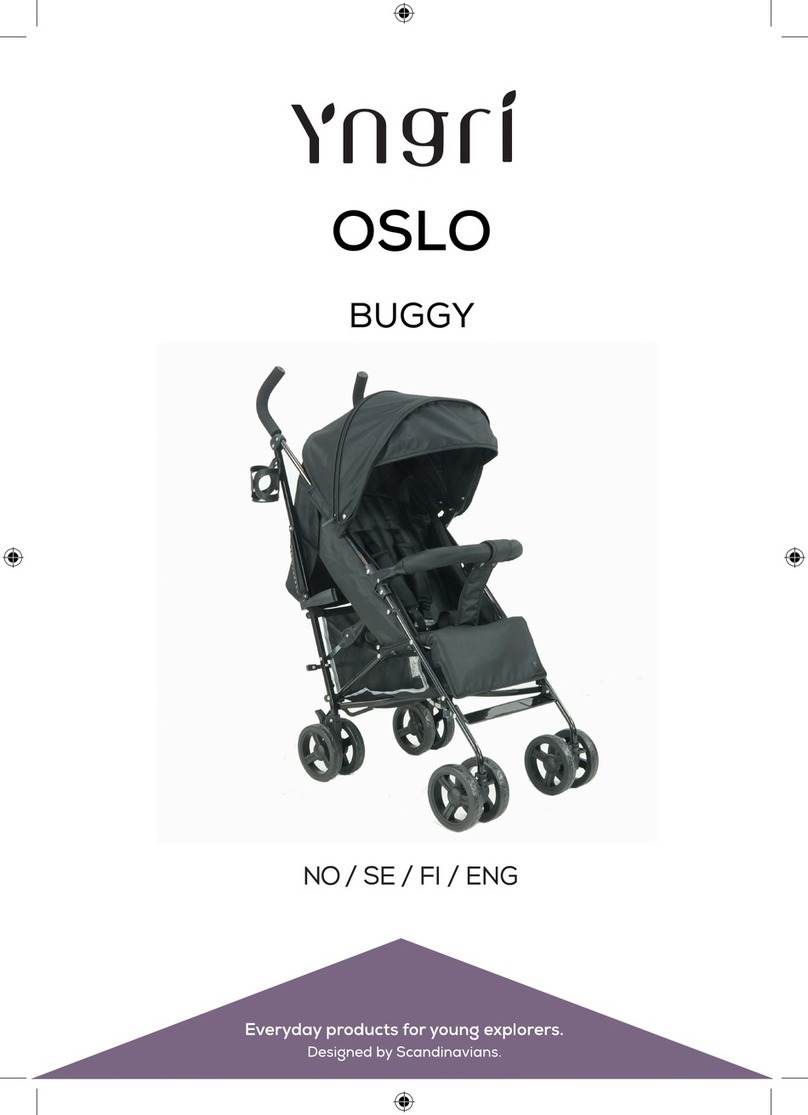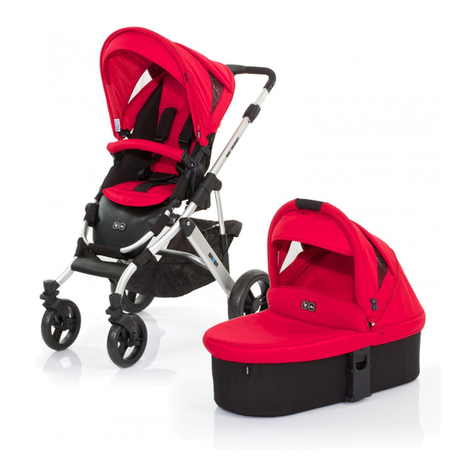Beemoo Sporty Trail User manual


2

3

4
1. WARNING
Read these instructions carefully before assembling and using the
product. Retain these instructions for future reference.
WARNING! Never leave the child unattended.
WARNING! Use a harness as soon the child can sit unaided.
WARNING! Always use the restraint system.
WARNING! This product is not suitable for running or skating.
(Unless the suitable jogger set is used accordingly.)
WARNING! This seat unit is not suitable for children under 6 months.
WARNING! Ensure that all the locking devices are engaged before use.
WARNING! To avoid injury ensure that the child is kept away when
unfolding and folding this product.
WARNING! Do not let the child play with this product.
WARNING! Check that the trailer is correctly assambled before use.
•The assembly may only be carried out by an adult.
•Not following the instructions and safety information in this
manual can result in serious injury or death to the passenger or
driver!
•Any additional load on the handlebar will affect the stability of
the trailer.
•Do not use this trailer on stairs or escalators.
•Do not transport additional children or bags with this trailer.
•Be careful not to pinch your fingers when folding and unfolding
this child carrier.
•Make sure that the child's limbs, clothing, laces or toys do not
come into contact with moving parts of the van.
•Do not install a car seat or other seating device.
•The maximum weight for one child is 22 kg.
•The maximum load of the luggage compartment is 6 kg.
•The parking brake must always be applied while children are
getting in and out.
•Always wear a helmet that complies with local regulations.
•Never ride at night without proper lighting. Follow all locally
applicable legal requirements regarding lighting.

5
•Be extremely careful when driving with the trailer. Do not drive
faster than 16 km/h and slow down to less than 10 km/h when
cornering and on bumpy roads.
•The drawbar load should not be less than 3 kg and not exceed
8 kg.
•Always fasten the safety catch strap of the hitch. Do not use the
bicycle trailer if you cannot attach the safety strap to the frame
of your bicycle for any reason! If the catch strap is not fastened,
the trailer can separate from the bike. The bicycle should be
safety checked by a qualified bicycle mechanic before using the
trailer.
•The child carrier becomes unstable if the manufacturer's
recommended load is exceeded. Do not use it for children who
exceed the maximum permissible weight.
•Before each journey, make sure that both wheels are securely
engaged in the axle of the transporter.
•This vehicle shall be used only for up to 2 children for which it
has been designed.
•Cycle trailers pulled by an EPAC can be restricted by law.
•Obey all local legal requirements.

6
2. PART LIST
A) Frame
B) Rear wheels with reflector
C) Jogger wheel (sold separately)
D) Wheel outriggers (sold separately)
E) Buggy wheels
F) Drawbar with axle coupling
G) Axle coupling
H) Safety pennant

7
3. ASSEMBLING
Assembling the Base Frame
1. Reach into the folded bicycle trailer and pull the handlebar.
2. Pass the frame part to which the handlebar is attached under
the linkage of the frame. Note: The angle of the handlebar can
be adjusted by pressing both grey buttons simultaneously.
3. Connect the frame part to which the handlebar is attached to
the frame of the bicycle trailer using the black fastening hooks.
4. Secure the black fastening hooks by turning the blue locks until
they engage.
5. The parts are correctly connected to each other when the
connection looks like in picture 5, the textile cover is taut and
nothing wobbles. Note: Secure the textile cover by folding it
over the frame and closing the Velcro fastener.

8
Folding the Base Frame
1.Set the handlebar to the lowest position.
Note: The angle of the handlebar can be adjusted by pressing both blue
buttons simultaneously.
2. Open the Velcro fastener that connects the textile cover to the frame.
3. To release the blue fastening hooks, press the blue fastening hooks
down until they are free.
4. Push the frame part to which the handlebar is attached downwards
until it is released from the anchorage. Pass this part under the frame
linkage.
5. Now fold the frame together.
6. The frame is correctly folded when it looks like in picture
Use of the Safety Belt
The 5-point safety harness system consists of two shoulder straps, two
lap straps and a crotch strap secured in a buckle. Padded shoulder straps
provide more comfort.
Warning: Never transport babies under 6 months or children who
cannot yet sit independently.

9
1. Open the straps by first pressing the red buttons and at the
same time the black buttons on the buckle. The individual straps
should now come out of the buckle.
2. let the crotch strap hang down towards the footwell and place
the two shoulder straps and the lap straps to the sides of the
seat for the time being, so that you can comfortably put your
child into the seat.
3. Place the child in the seat with the harness open.
4. guide the crotch strap with the buckle between the child's legs
upwards to the upper body. 5. Guide the hands away from the
child.
5. pass the child's hands between the shoulder straps and lap
straps. Place the shoulder straps over the child's shoulders.
Now insert the ends of the straps into the buckle. Tip: The seat
belts can be adjusted to the child's height.
6. Adjust the seat belts so that the child is held securely by the
belts, but not so tight that the seat belts cut in. Tip: If a flat hand
can be slid between the straps and the baby's body, the straps
are usually adjusted correctly.
Warning: The distance between the shoulder and lap belts and the
child's body should be as small as possible so that the child is held
optimally in the seat. If the distance is too great, the child cannot be
restrained sufficiently in the seat, which can lead to life-threatening
injuries in the event of an accident. If the distance is too small, the
seat belts may possibly cut into the child's body.
Warning: Always fasten the child's seat belt! Your child could
otherwise suffer life-threatening injuries in dangerous situations.
Warning: Seat belts that are adjusted too loosely or buckles that are
not properly fastened can cause life-threatening injuries to your
child in the event of an accident.

10
Attaching the Rear Wheels
Insert the rear wheels into the openings on the frame. When you hear a
click, the rear wheels are correctly fixed and locked in place. Note: The
rear wheels can be removed by pressing the button located in the middle
of the wheel. Then fix the disc brake with two screws in both side by tool.
Warning! After mounting, check the locking by pulling both wheels back
and forth! The wheels must not be able to be pulled out without pressing
the button. Wheels that are not fully locked can come loose when riding,
which can lead to accidents with life-threatening injuries.
Note: The bicycle trailer has a wheel guard. Always fold the wheel guard
outwards when using it as a bicycle trailer. The wheel guard protects the
rear wheels from collision.
ATTENTION! The right tires are essential! Use only the tires supplied and
keep them properly maintained. Inflate the tires to 30-35 P.S. I. and check
the pressure before each use. Do not use higher pressure tires as this will
make the trailer bouncy and pro- ne to tipping over when lightly loaded.
We recommend only tires with road tread. Do not use off-road tires.

11
NOTICE! The wheel guard protects the
wheels from collisions with obstacles.
Set and Release the Parking Brake
The parking brake prevents the bicycle trailer from unintentionally rolling
away when stationary. It is not suitable for braking a rolling bicycle trailer.
Always apply the parking brake when you:
1) Park the jogger or buggy.
2) Allow your child to get in and out of the trailer when using it as a
jogger, buggy or bicycle trailer.
3) Fold the trailer so that it does not roll away.
The parking brake is operated by a brake lever located on the handlebar
and acts on both wheels release the foot brake.
The parking brake can be fixed by pressing the silver button on the brake
lever. The parking brake can be released by pulling the brake lever again.
WARNING! Always apply the parking brake after parking the trailer
and when getting in and out of the trailer with the children. Check
that the trailer cannot roll away by pulling it slightly forwards and
backwards. An
unsecured trailer could
cause accidents with
life-threatening injuries
by rolling away or could
roll away when getting
in or out of the trailer,
causing serious injuries
to the children.
WARNING! Never drive
with the parking brake
applied! This can
damage the brake
mechanism.

12
Attaching the drawbar (bicycle trailer configuration)
1) Insert the drawbar into the opening on the frame. The opening is
located under the front reflector.
2) Secure the drawbar with the blue clamp. To do this, insert both steel
bolts of the clamp into the holes on the side of the bicycle trailer and close
the clamp. The clamp is securely closed as soon as you hear a loud
clack.
Note: Opening and closing the clamp is not smooth and requires a
certain amount of force. This is necessary to guarantee a secure hold of
the clamp.
ATTENTION! Both steel bolts must always be locked with the clamp
when the trailer is used. Always make sure that the drawbar is securely
mounted. Failure to do so may result in serious accidents and injuries.
3) The drawbar must always be mounted on the left side of the bicycle
trailer. The drawbar must not be mounted on the right-hand side.

13
Mounting the Axle Coupling (quick release)
The coupling is always mounted on the left-hand side of the tractor wheel,
as seen in the direction of travel. It consists of two parts: the drawbar
head, which is attached to the drawbar, and the axle coupling, which is
attached to the axle of the rear wheel hub of the towing bicycle. Before
you mount the axle coupling, you must determine whether your bicycle is
suitable for towing a trailer. Check the owner's manual of the bicycle, ask
the manufacturer, or ask a bicycle dealer.
Warning! The axle coupling must be fitted correctly. An incorrectly
mounted axle coupling can come loose while riding and lead to
accidents with life-threatening injuries.
1. Open the quick-release lever on the rear wheel of the traction
bike or loosen the hexagon socket screw (5 mm), depending on
the version of the quick-release axle. Often the direction of
movement of the clamping lever is marked "OPEN".
2. Unscrew the quick-release axle nut anticlockwise. Be careful,
there is a small spring underneath that could jump away.
3. Place the axle coupling on the quick-release axle without
removing the spring.
4. Screw the axle nut clockwise onto the thread of the quick-
release axle with at least five full turns.
5. Align the rear wheel and close the quick-release lever or tighten
the hexagon socket screw, depending on the quick-release axle
version. The direction of movement of the clamping lever is
often marked "CLOSE”. The force you apply must increase from
about halfway. In the last area shortly before the end position,
the clamping lever should be difficult to move. In the end
position the lever must be parallel to the frame and must not
stick out.
6. Check whether the quick-release is really tightly closed by trying
to turn the closed quick-release around its own axis . If the quick
release can be twisted, the clamping force is not sufficient.
Open the clamping lever and screw the axle nut half a turn
clockwise. Repeat steps 5 and If the clamping lever cannot be
closed completely, open the clamping lever and screw the axle
nut half a turn anticlockwise. Repeat steps 5 and 6. Note that
the axle nut must be screwed onto the thread of the quick-
release axle with at least five full turns.

14
Warning! Less than five full turns of the thread will not ensure
sufficient clamping force of the rear wheel, which can lead to
accidents with life-threatening injuries. The quick release axle is
then too short and must be replaced. This is available as an
accessory. Contact a specialist workshop.
7. Finally, try to move the rear wheel in the dropouts to make sure that it
is correctly fixed.
Warning! The rear wheel must be correctly fastened after mounting
the axle coupling. An incorrectly fastened rear wheel can lead to
accidents with life-threatening injuries when riding. Refer to the
instruction manual of your towing bicycle. There are many different
axles. If in doubt, consult a specialist mechanic.

15

16
Assembly of the Axle Coupling (solid axle)
The coupling is always mounted on the left-hand side of the tractor wheel,
as seen in the direction of travel. It consists of two parts: the drawbar
head, which is attached to the drawbar, and the axle coupling, which is
attached to the axle of the rear wheel hub of the towing bike . Before you
mount the axle coupling, you must determine whether your bicycle is
suitable for towing a trailer. Check the owner's manual of the bicycle, ask
the manufacturer, or ask a bicycle dealer.
Warning! The axle coupling must be fitted correctly. An incorrectly
mounted axle coupling can come loose while riding and lead to
accidents with life-threatening injuries.
1. Unscrew the axle nut on the left side of the rear wheel
counterclockwise.
Warning! Do not remove the lock washer (2). It prevents the rear
wheel from twisting in the dropouts. Riding without lock washers
can lead to accidents with life-threatening injuries.
2. Place the axle coupling on the axle without removing the lock washer.
3. Screw the axle nut onto the thread of the solid axle with at least five full
turns.
Warning! Less than five full turns will not ensure sufficient clamping
force of the rear wheel, which can lead to accidents with life-
threatening injuries. The axle coupling must not be fitted! Contact a
specialist workshop.
4. Align the rear wheel and tighten the axle nut to the tightening torque
specified in the instruction manual of your towing bicycle. Hold the axle
coupling firmly.
5. Finally, try to move the rear wheel in the dropouts to make sure it is
correctly secured.
Warning! The rear wheel must be correctly fixed after mounting the
axle coupling. An incorrectly fastened rear wheel can lead to
accidents with life-threatening injuries when riding. Observe the
operating instructions for your towing bicycle. If in doubt, consult a
specialist workshop.

17

18
Attaching the Safety Pennant (bicycle trailer
configuration)
To ensure that the bicycle trailer is better seen by other road users, you
should always use the safety pennant provided. This increases your
safety and that of your child. The safety pennant is inserted into a fabric
tunnel located on the left side of the fabric cover.
1. put the two parts of the frame together. 2. put the safety pennant
together.
2. put the safety pennant into the fabric tunnel on the fabric cover.
Warning! If you use the bicycle trailer as a bicycle trailer, the safety
pennant must always be fitted. Without the safety pennant, the
bicycle trailer could easily be overlooked in road traffic, which could
lead to accidents with life-threatening injuries.
Note: When folding the trailer, remove the safety pennant beforehand.
Otherwise, the pennant pole could break.

19
Coupling the trailer to the bicycle (bicycle trailer
configuration)
Warning! Check whether the towing bike is approved by the
manufacturer for towing trailers! Pulling trailers with an unsuitable
towing bike can lead to frame fractures and accidents with life-
threatening injuries.
Coupling should always be done without a child in the trailer.
1. open the safety bar of the cotter pin. The cotter pin is located on the
drawbar head and remove the cotter pin.
2. Lift the drawbar and push the drawbar head onto the axle coupling
mounted on the bicycle.
3. Put the cotter pin back into the hole provided on the drawbar head and
close the safety bar. Caution. Make sure that the connection is secure by
pulling on the drawbar.
4. Pass the safety strap around the frame tube and hook the carabiner
into the holder on the drawbar. Make sure that the safety strap does not
get caught in the spokes or disc brakes.
Warning! Make sure that the axle coupling is correctly fixed in the
drawbar head. If it is not fixed correctly, the trailer may come loose
while driving, which may lead to accidents with life-threatening
injuries.
Warning! Never drive without securing the drawbar with the safety
strap! If the trailer comes loose, it will still be connected to the
bicycle. Failure to observe this can lead to accidents with life-
threatening injuries.

20
Mounting the buggy wheels (buggy configuration)
If the bicycle trailer has the drawbar or the jogger wheel set mounted, first
remove these elements and insert the blue fastening hooks back into the
holes provided. Make sure that the fastening hooks are closed.
Tip: To familiarise yourself with the assembly, we recommend that
you first lift the bicycle trailer at the front, tilt it backwards and
support it on the handlebar. Make sure that the surface under the
trailer is clean and smooth so as not to soil or damage the textile
cover. Later, when you are familiar with the assembly, it is enough
to lift the trailer slightly at the front for this work.
1. lift the trailer at the front or tilt it backwards.
2. insert the buggy wheel into the buggy wheel holder as far as it will go
until you hear and feel it engage.
3. to remove the buggy wheel, press the blue button and pull the buggy
wheel out.
Mounting the jogger wheel (jogger configuration)
If the drawbar or the buggy wheels are mounted on the bicycle trailer, first
dismantle these elements. The jogger set consists of two-wheel arms, a
jogger wheel and a catch strap. The two-wheel outriggers are mounted in
a similar way to the drawbar. The left-hand outrigger is inserted into the
receptacle of the drawbar and the right-hand outrigger is inserted into an
identically constructed receptacle on the right-hand side.
1. Lift the trailer at the front or tilt it backwards.
2. Now insert the jogger wheel into the dropouts of the wheel arms and do
not tighten the axle nut completely.
3. open and remove the blue clips. Then insert the wheel arms into the
receptacles. The blue adjustment wheels must point downwards.
Other manuals for Sporty Trail
1
Table of contents
Languages:
Other Beemoo Stroller manuals
